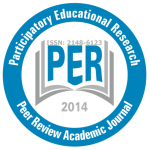First Control Process
• It is checked whether the instructions given in the preparation section are followed.
• It is checked if the article has been prepared according to the template presented in the preparation section.
• If the research is descriptive, it is checked whether it has been studied with more than one variable.
• It is checked whether the submitted article has been scientifically reported.
• The method used, the data collection tools, and the analysis of the data steps are checked if they are explained correctly.
• The potential level of contribution to the international literature through the paper and its subject in question is checked.
• Similarity report is checked. Similarity report should be performed using Turnitin or iThenticate. In the similarity report, the number of excluded words should not be more than 5 words and the similarity rate should not be more than 15%. Studies that do not provide these explanations will be rejected without any review. Besides, for any matters including the aforementioned one, the board makes the final decisions in this regard.
• It is checked whether the article is arranged in accordance with the IMRAD (Introduction, Method (Research design, Working group, Data collection tools, Data analysis, Experimental process, and Teaching environment [for experimental studies]), Result, Discussion and Conclusions) format.
Please note that the study is sent to the field editor after going through the above processes.
Peer-Review Process
• At least two referees who are experts with PhDs on the subject discussed in the article are invited to review it.
• The invited referees are given 5 days to accept the invitation. If this period is exceeded, this period is extended for 15 days for once. If the invitation is not accepted within this period, another referee is invited.
• The referees whose invitation is accepted are given 15 days for review. An additional period of 15 days is given for once only, for the examinations that are not completed even though the period has expired. If the review is not completed at the end of this period, the duty of arbitration is canceled, and another referee is invited. Please be informed that due to unforeseen circumstances like the Covid-19 pandemic the timeframe for the evaluation of papers can be expanded.
• If, as a result of the review, both referees give an acceptance or minor correction string, the article is accepted by asking the author to make the necessary revisions in light of the referee comments and editor’s notes (if any).
• In case of acceptance or minor revision of one referee and major revision of the other, the major revision decision can be reviewed by the editor, and it may be decided by the editor to invite a revision or a third referee.
• In case of acceptance or minor revision of one referee and rejection of the other, a third referee is invited. The decision is made in line with the suggestions of the third referee.
• If both referees give a major revision or rejection decision, the study is rejected.
• Referee comments are reviewed by the editor. If it is understood that the referee has made inappropriate, unfair, or subjective evaluations, the relevant referee’s opinion will not be taken into account. Another referee is invited to replace them.
• The refereeing process may differ depending on whether the referees respond to the invitation in a timely manner, complete the review on time, if a third or more referees are required. This period can vary between 1-8 months on average.
• The necessary revisions should be made by the author within 15 days and uploaded to the system in line with the recommendations of the referee and the editor once the referee processes are completed.
• Revisions made in the full text of the article should be marked in red by the author.
• In addition, revisions or explanations made to a different word document should be produced as articles and uploaded to the system as an additional file.
• The revisions made can be reviewed by the relevant editor, and an acceptance decision can be made, or an additional referee’s opinion can be requested.
Publishing Process
• A publication editor is assigned to the accepted article and sent for final reading.
• The language editor is given 15 days for final reading.
• If the language editor decides that proof-reading is required, the article is sent to the author for proof-reading.
• The article whose proof-reading process is completed or for which the language editor requests minor revision is sorted by the publication editor. The author is requested to make minor language revisions as well as to review the sequenced work and make other revisions, if any. This is the last chance given for authors to revise their work.
• Studies approved by the authors are reviewed and approved by the chief editor.
• The articles approved by the editor-in-chief are assigned to the first available issue. It is published in early view form and assigned a DOI number.
• For any reason, no changes can be made on the studies that are published as early view and assigned a DOI number. However, requests addressing major issues spotted by the authors and other audience are first evaluated by the board and then the necessary corrections can be made in this regard.

